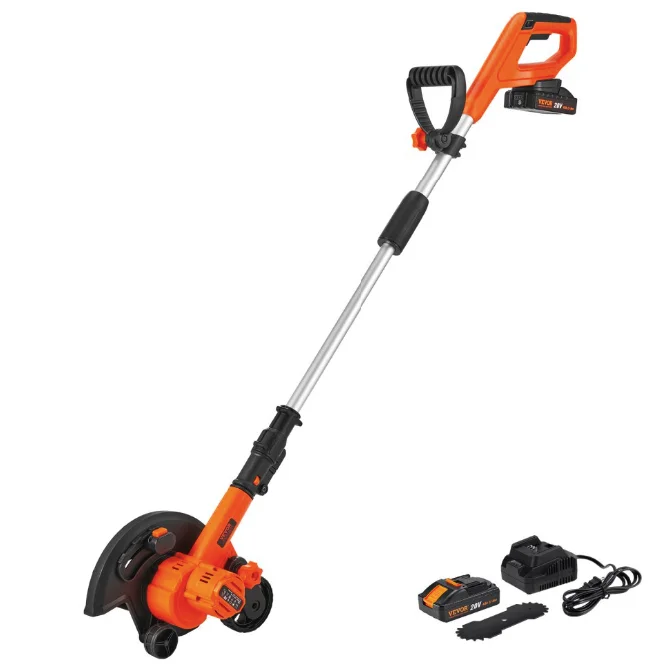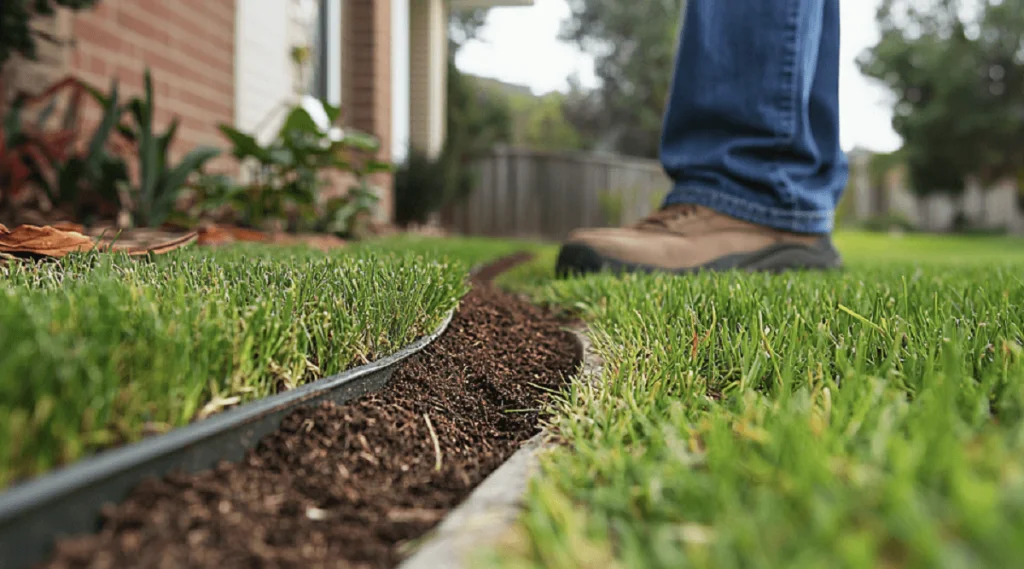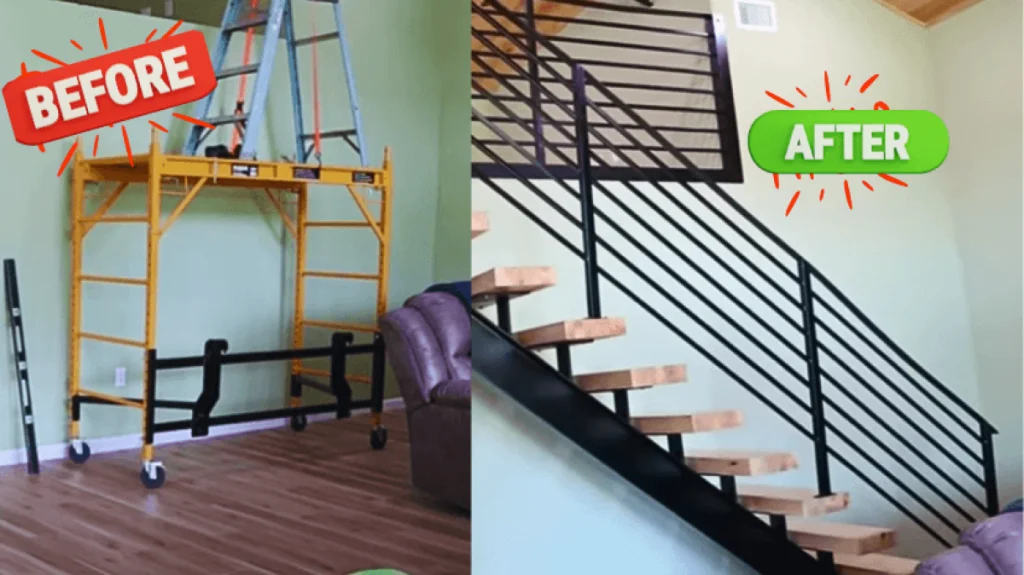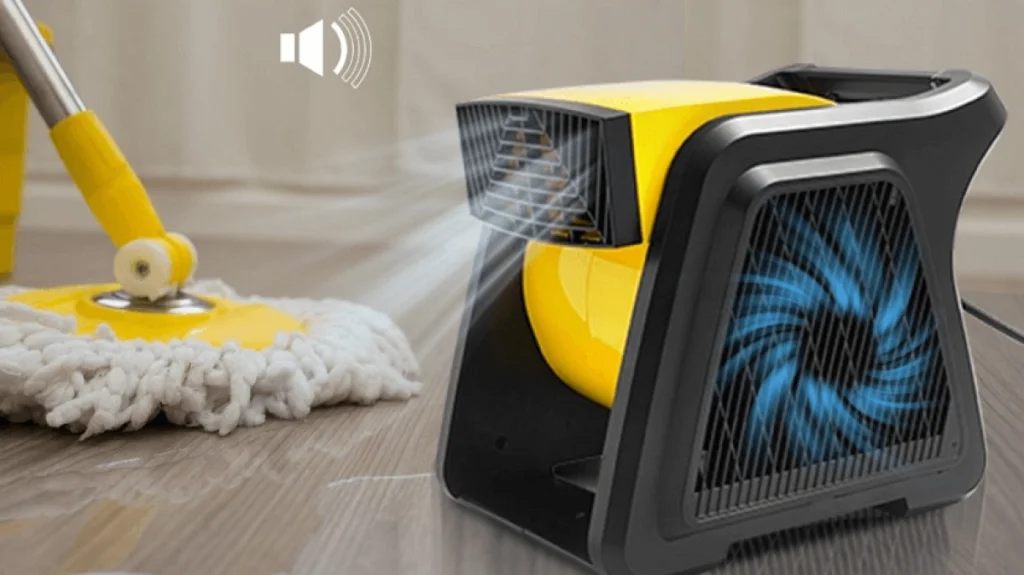Does the grass on your lawn keep growing over boundaries and invading your sidewalks and walkways? If it does, then it’s time to consider edging.
A well-edged lawn not only improves the overall aesthetic of your home but also makes trimming and mowing much easier. So if you want to get “oohs” and “aahs” from people who walk by your lawn, you need to learn how to edge a lawn properly.
In this guide, we’ll discuss the different benefits of edging a lawn, with step-by-step instructions on how to edge grass. That’s not all. We’ll also mention the types of tools you should use to get the best results.
Speaking of tools, one of the best investments you can make for edging a lawn is the VEVOR lawn edger. It is a high-quality lawn edger equipped with a 4000mAh high-efficiency battery. It also has a 9-inch blade with up to three different depth adjustment settings.
Read on to learn more features about the VEVOR lawn edger and how to use it to edge your lawn like a pro!
Table of contents
What is Lawn Edging?
The first step to understanding how to edge a lawn is understanding what exactly lawn edging is.
Understanding Lawn Edging and Its Benefits
Lawn edging refers to the process of creating a defined boundary between a lawn and the adjacent area. This could be a driveway, sidewalk, walkway or path. If mowing is giving your lawn a haircut, then lawn edging is styling it.
By edging, you create a clean separation between the grass and the surrounding soil, thereby accentuating the overall space and highlighting the beauty of the grass. Lawn edging is a common practice because it:
- Helps you maintain a tidy landscape by preventing grass from spreading to unwanted areas
- Makes your lawn easier to mow, reducing the time needed for routine maintenance
- Helps maintain healthy grass growth
- Enhances the overall curb appeal
Different Types of Lawn Edging Tools
You can edge your lawn with various tools, which are broadly categorized into manual and powered lawn edgers.
- Manual Lawn Edgers: If you have a small yard or are not experienced enough to handle powered lawn edgers, you can use manual tools. Some of the most popular manual edging options include edging shears, garden spades, and half-moon edgers.
Edging shears look like large scissors and can be used to trim your lawn borders and driveway edges. For something more handy or portable, you can use the sharp blade of a garden spade or half-moon edgers which have half-moon-shaped blades.
- Powered Lawn Edgers: As the name suggests, powered lawn edgers operate when they are connected to a power source or have been recharged prior to use. These lawn edgers are more efficient and precise compared to the manual ones, and they provide a more professional finish.
The VEVOR lawn edger, in particular, is one of the most reliable powered lawn edgers that can take your lawn from drab to fab within minutes. It is a lightweight cordless edger that weighs only 9.3 lbs/4.23 kg, making it easy to lift even during lengthy edging sessions.

How to Edge Grass: Essential Preparation
Lawn edging is a meticulous process that requires careful preparation and set-up in order to achieve the best results. First, you gather the necessary tools, and then you prepare your lawn for edging.
Let’s break this down further.
Gather the Necessary Tools and Materials
You’ll need tools like:
- Lawn Edger: Well, of course, there will be no lawn edging without a lawn edger. If you opt for a high-quality tool like the VEVOR lawn edger, you can edge for as long as 40 minutes at a single charge. Its 9-inch blade is also designed to work on both low and high lawns that are up to 11” tall.
- Measuring Tape: This is for taking precise measurements to create the boundary you want for your lawn edges.
- Rake or Blower: To ease the cleanup process once you’ve completed lawn edging.
- Gloves: To protect your hands from any accidental nicks.
- Safety Glasses: To keep your eyes safe from any flying debris or grass that may come up while you’re edging the lawn.
Safety First: Preparing Yourself and Your Lawn
Using power tools such as lawn edgers can pose many risks if they are not handled properly. Therefore, it is important to put safety first. You can do this by:
- Always use safety glasses, gloves, and closed-toe shoes to stay protected from debris
- Checking for and removing large clumps of dirt or garbage that may interfere with the edging process
- Steering clear of any power lines or pipes that can easily get damaged while you work
- Removing obstacles like rocks, sprinkler heads, or large sticks
- Keeping children and pets away from the lawn while you edge it
Recommended For Your Project
How to Edge Your Lawn: Step-by-Step Guide
Now that we’ve covered all the basics let’s discuss how to edge a lawn in detail.
Step 1: Marking the Edge for Straight Lines
Lawn edging is a meticulous process that often begins with a plan. Before you start edging, you must create marks along the edge of the grass to guide you as you trim the grass. You can use a string line or an edging tool to create a clear boundary that signifies where the lawn starts and ends.
This process is also called delineating the path. Besides using a string line, you can also use a tape, rope, or hose to mark the boundary. Avoid using spray paint to mark the edge as it can easily get messy or leave permanent marks on your grass.
Step 2: Setting the Lawn Edger’s Blade Depth
Now it’s time to set the lawn edger’s blade to your desired depth. The depth of your lawn edger’s blade will largely depend on the type and thickness of grass you’re cutting. Always maintain a consistent depth setting, as this will create a uniform look.
As a safety precaution, always ensure the lawn edger is off before you set the blade, as this will help you avoid any accidental nicks.
Step 3: Operating the Lawn Edger for Best Results
To get a perfectly cut lawn edge, you must pay attention to the stance and grip you adopt while holding the lawn edger. Maintain a consistent pace while you walk the length of the lawn, and use a steady grip to keep the lawn edger firmly in place. To get a solid stance, keep your core engaged, your eyes on the lawn, and your arms straight.
If you want to create both straight and curved edges, start with the straight edges, as they are easier to handle. If you’re edging your lawn in a straight line, work your way steadily from point A to point B. On the other hand, if you’re edging a curve, you can start from any point. However, always maintain a clockwise or anti-clockwise progression to avoid uneven cuts.
Step 4: Techniques for Edging
Edging a curved line may require some finesse. Hold the lawn edger at an angle that follows the natural contours of your lawn. Keep an eye on the position of the lawn edger’s blade to avoid scalping the lawn.
As a rule of thumb, if you’re working with a curved edge, use a slow pace, as this will help you maintain a smooth edge.
Step 5: Finishing Touches After Edging
Before putting away the lawn edger, inspect the edges you’ve created to ensure you haven’t left anything out. If there are minor adjustments to be made, keep the lawn edger at a low speed and go over the lawn edge one more time.
After you’ve completed the edging process, it’s clean-up time. Clearing up leaves, debris, and grass clippings will help you achieve a tidy lawn.
To clean up, you can use either a rake or a blower. The VEVOR leaf blower can come in handy for this purpose. With a speed of about 252km/h, it is a high wind blower that can ease the clean-up process, leaving your lawn looking brand new.
Common Mistakes to Avoid When Edging a Lawn
Sometimes, mistakes can occur while edging a lawn. But don’t fret; there are still ways to fix them.
Uneven Edges and How to Fix Them
If you fail to maintain a steady pace, consistent stance, or good grip on the lawn edger, you’ll end up with uneven edges, which are unattractive. This is one of the most common mistakes people often encounter while edging their lawns.
To fix an uneven edge, you need to create markings again and delineate the lines you would like to follow. Next, fire up the lawn edger and go over the process one more time. Try to maintain a good pace and grip and consistent blade depth.
Over-Edging: Knowing When to Stop
One of the most frustrating things that could happen as you edge your lawn is over-edging, which can lead to scalped grass. While you don’t want to keep re-doing the lawn edge, you also don’t want to end up with scalped grass, which can look patchy and unappealing.
To avoid this, do not go over the same spot multiple times, no matter how tempting it is. Instead, edge the same spot once or twice and complete that particular area before stepping back to assess it. That way, you can easily know if you need to redo it or not. Remember, you can always go back to take more grass out, but you can’t add it in.
In the event that you do end up scalping your grass, you’ll need to carry out lawn repairs in that area and try to grow the grass back.
Why Choose VEVOR Lawn Edger?
Now, the key to a perfectly cut lawn edge is the lawn edger you use. Here’s why the VEVOR lawn edger is easily your best choice.
Key Features and Benefits of VEVOR Lawn Edger
The VEVOR lawn edger is an effective tool because it is equipped with all the features you need to achieve a perfect lawn edge. Let’s highlight these features one after the other.
- High Power: With a 4000mAh high-efficiency battery, the VEVOR lawn edger can be used consistently without the need for frequent recharge. This tool is also designed to edge your lawn fast at a speed of about 20000 rpm. This allows you to edge the lawn quickly and more efficiently.

- Light Weight: Lawn edging can get pretty tiring, especially if you have a large lawn or yard. However, the light weight of the VEVOR lawn edger, which is only 9.3 lbs/4.23 kg, makes it easy to use for extended periods without developing hand fatigue.
- Depth Adjustment: With this tool, you can basically cut to any depth you want. With three different depth adjustments, you have the flexibility to edge your lawn according to your preferences.

- Blade Size: The VEVOR lawn edger’s 9-inch blade is powerful enough to cut between 3 and 11 inches deep. It works well with different types of lawns and grasses, including Bermuda grass, Bluegrass, Ryegrass, and St. Augustine grass.
- User-Friendly: Whether you’re an expert or a newbie, you’ll have no trouble using the VEVOR lawn edger. It is user-friendly and has an ergonomic handle that helps you maintain a steady grip while working.
Customer Testimonials and Reviews
Let’s hear what real-life customers have to say about the VEVOR lawn edger.
Bruce, a satisfied customer, rated this tool five out of five stars with the following review: “This is the best edger I have ever used. It did a great job for my driveway edging, which had a lot of roots to edge out. I highly recommend it.”
Another satisfied customer named William Kiesgen gave it a four out of five stars, and said, “I like it. Received as advertised and works well.”
Frequently Asked Questions About Lawn Edging
To broaden your understanding of how to edge grass, here are some FAQs about lawn edging.
Can I Edge My Lawn Without a Lawn Edger?
Yes, you can successfully edge your lawn without a lawn edger by using tools such as spades. However, doing this makes the process longer and more labor-intensive, although they may cost less. On the other hand, using a lawn edger will get the work done much quicker.
How Often Should I Edge My Lawn?
Edging a lawn should be done as often as once a month during the growing season. This will help to keep your lawn looking tidy at all times. The frequency of edging a lawn can also change, depending on how well you maintain it.
How to Maintain a Lawn Edger for Long-Term Use?
The best way to get the most out of your VEVOR lawn edger is by maintaining it regularly. This means you should clean the blades thoroughly after each use and store the lawn edger in a clean, dry place when it’s not in use. If you encounter any issues while setting up, you can easily refer to the manual for instructions on troubleshooting.
Conclusion
And that’s it! Your ultimate guide detailing how to edge a lawn like an expert. To successfully edge a lawn, you need tools like measuring tape, lawn edger, rake or blower, gloves, and safety glasses.
Start by marking the edge for straight lines or curved lines, depending on the design of your lawn. After that, set the lawn edger’s blade to your desired depth and then start edging. Don’t forget to use safety glasses and gloves because lawn edging accidents can get pretty nasty!
The key to successfully edging a lawn is to use a high-quality lawn edger. With the VEVOR lawn edger, you’re guaranteed great results each time you use it.
It is a high-power tool that comes with a battery and charger and has a 9-inch large blade designed to tackle any type of grass on your lawn. It also has a 20,000 rpm motor speed and a 3,200 rpm blade speed. This means you can finish edging your lawn within a short period without experiencing unnecessary hand fatigue.
So, what are you waiting for? Try the VEVOR lawn edger today and give your lawn the makeover it needs!





